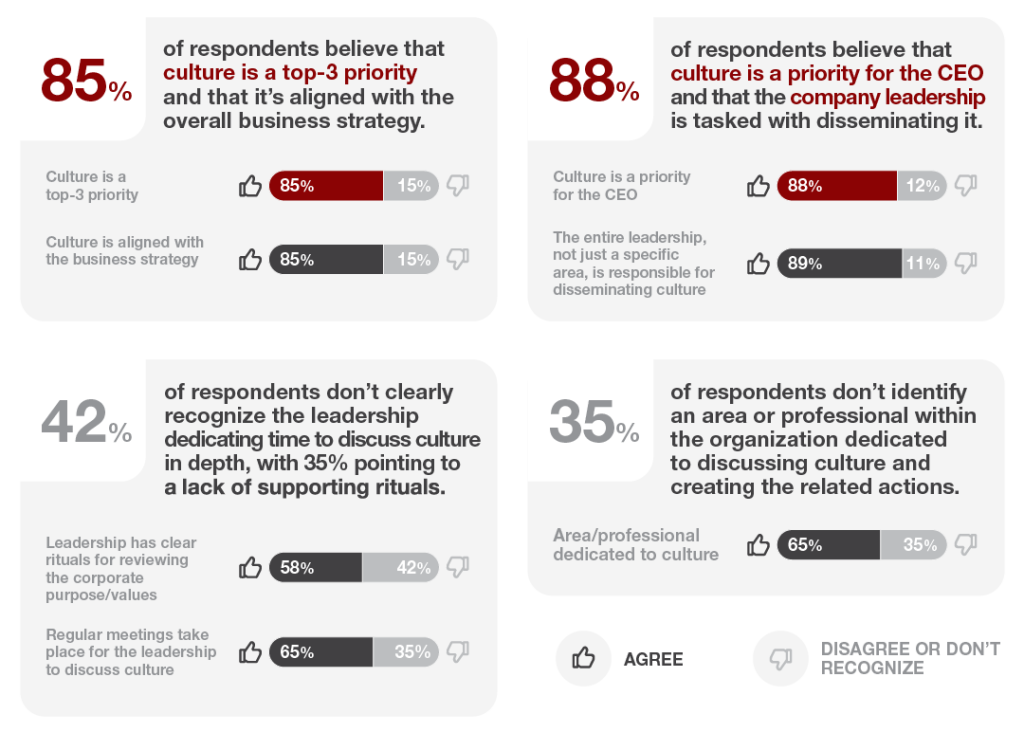
Organizational Culture: A lever for driving the business strategy
Why set culture as a priority?
Culture serves as a source of energy that directs the behavior of professionals within an organization. Companies that effectively translate their declared (official) culture into practice imbue their organizations with vitality and strategic coherence.
Experience shows that those who prioritize culture achieve better organizational health, via stronger connections between individuals and the organization as a whole, but also an improved capacity to respond to market demands and deliver on their corporate purpose.
Among many of our clients, we frequently see organizational culture assuming particular importance at several critical junctures. This includes moments such as the succession of a new CEO, M&A processes, entry into new markets and whenever business performance is below expectations.
Regardless of the situation, there are several things to consider when approaching organizational culture:
- The starting point in any cultural journey involves understanding the culture actually being practiced within the organization, and not merely the one that’s officially declared or expressed as an objective. While there is no right or wrong, it’s essential for the leadership to diagnose the company’s strong points that should be maintained, along with the development points that need to be addressed.
- Cultural change demands taking a structured approach based on coordinated efforts that are integrated with the business as well as its strategy. This will allow culture to mobilize individuals and create a basis for engagement.
- A connection must be established between theory and practice, meaning that culture must be approached as an ongoing process.
While each company goes through its own unique cultural journey, the essentials remain the same. Unlocking the power of organizational culture rests on three common elements:
With this context in mind, we carried out a survey with the participation of different companies to identify how culture is being interpreted and applied in different organizations.
Key survey insights

IN SHORT
Implementing culture in a systematic way represents a serious challenge for organizations.
IN SHORT
Even if culture is perceived, a lack of alignment may exist in how it is translated and applied across levels of the organization.
IN SHORT
Even if culture is perceived, a lack of alignment may exist in how it is translated and applied across levels of the organization.
The 6 stages of applying organizational culture
Organizations face different challenges that place them in different places along the cultural journey.
Our survey led us to identify different maturity stages of organizational culture: from those effectively extracting value from culture to promote the business to those still playing with the idea of making the investment into culture.
Based on the results observed, we have established 6 stages of maturity into which organizations can be categorized.
Stages I & II of applying culture

While most companies surveyed have turned culture into a strategic business priority, some still question its importance and others struggle to align leadership to start making it tangible in day-to-day practice.
Integration insights for these stages:
- Prioritizing implies choices: The organization must have a clearly aligned vision that places the right degree of importance on culture – considering it as part of the business strategy that can promote better results.
- CEO as the captain: To evolve and address the company’s culture, actions must be led top-down, starting with the CEO.
- Leadership must act: Leaders must be disseminators, this means dedicating time to address, debate and structure the culture strategy.
Stages III & IV of applying culture

A sizable number of the companies we surveyed have a solid basis but struggle to turn the culture they seek into concrete actions across their employee value proposition.
Integration insights for these stages:
- Coherence is crucial: Strong culture lives on consistency between what’s said and what’s done. Insufficient coherence between the two can lead staff to interpret the defined culture in their own way – easily causing divergence in understanding.
- Formal and informal initiatives: We recommend having processes, rituals and tools in place, backed up by concrete experiences. Incomplete initiatives that fail to deliver excellence can have a negative impact and undermine perceptions of culture.
- Impact vs. effort: Focus on actions that generate impact and can become milestones on the journey. This will allow the organization to start reaping the benefits of a culture strategy sooner.
Stages V & VI of applying culture
Our survey shows that many companies are quite advanced in their cultural practices. Despite that, a persistent challenge is remaining vigilant to address needed course corrections and keep providing the organization with concrete examples.
Integration insights for these stages:
- Measuring is important, acting is essential: Reaching a common understanding of culture rests on the collaborative efforts of leadership paired with measurement tools to gauge the effectiveness of their efforts.
- Directed actions are needed: Concrete actions should be in place to target the primary pain points identified by the monitoring tools.
- Being exemplary in “moments of truth”: The way that the organization behaves in critical moments will prove that the culture is true and coherent.
Which stage is your organization currently at?
The first step of any cultural transformation is to assess
the current state of culture at the organization.
With a clear picture of your cultural maturity level, the company can identify and prioritize the actions needed to strengthen its organizational culture.
This will help improve the quality of the employee value proposition while also adding value to the business strategy in general and delivering results in the long term.
Survey methodology
The survey aimed to understand market practices on organizational culture as well as the different stages in which organizations find themselves in relation to the topic. It was sent out to over 100 senior professionals from diverse areas and companies of different sizes and sectors in Brazil. The response rate was 70%, allowing us to achieve a highly relevant sample.
Find out more by reading the full report
TALK TO US
- On 25 June 2024






